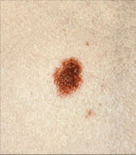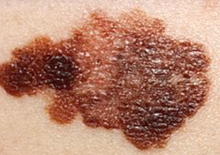Face and Neck Melanoma: Skin Cancer Treatment and Restoration
Tuesday April 22nd, 2014
 |  |  |
PRE MELANOMAS (LEFT IS DYSPLASTIC NEVUS) AND MELANOMAS
Face and/or neck melanoma is a type of skin cancer that is becoming increasingly common, yet still remains possible to effectively and expertly treat. While the primary treatment plan typically involves surgery to remove the affected area, cosmetic surgery can be a vital part of the recovery phase to restore a natural and vibrant appearance to the skin.
As a board certified plastic surgeon with more than 30 years of experience, Dr. Lewis Obi can contribute to the recovery phase of face and neck melanoma with precise and accurate restorative techniques he has perfected over the last three decades.
Face and Neck  | Melanoma Symptoms  |
Melanoma occurs when cells known as melanocytes undergo a change that makes them produce a skin pigment known as melanin. This production of melanin often results in a darker or changed appearance in moles or other areas on the skin. Moles that were previously benign can often develop into melanomas, or the condition can erupt in the form of a new mole, lump, sore or growth on the skin.
One way to spot check for melanoma symptoms is to rely on a system based on the acronym ABCDE. Warning signs may often be recognized by:
- Asymmetry: Abnormal areas that are asymmetrical in nature, or one half different in appearance than the other half
- Borders: Irregular edges around the growth
- Color: Various shades of color or a mixture of colors in the area, usually hues of tan, black, brown, white, red or blue
- Diameter: Abnormal areas that are about the size of a pencil eraser, or 6 mm in diameter, although melanomas have been known to be smaller
- Evolution: Moles that keep evolving, or changing in appearance
People Most at Risk
While aging can increase the risk of developing melanoma, it is not uncommon for younger people to be affected. Those most at risk include people with fair skin, green or blue eyes, or blond or red hair. Geography can play a role, with a higher risk in areas that have consistently sunny climates or a high altitude. Spending excessive amount of time in strong sunlight can also increase the risk, as can a history of blistering sunburns as a child.
A family history of melanoma may increase an individual’s chances of developing the condition, as can multiple birthmarks or certain types of moles. Two more factors that can contrib




